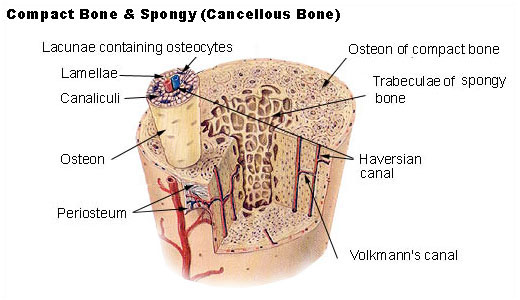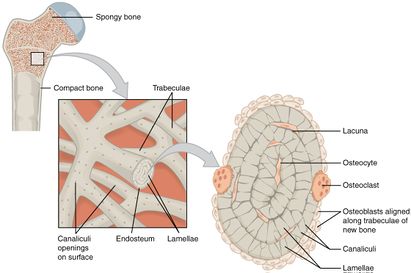Mechanical Loading of Bone
Introduction[edit | edit source]
Bone mass is regulated by both mechanical and biochemical stimuli. Like muscles, bones add mass when they are loaded (physical activity) and will lose mass if they are not (immobilisation or time spent at low or zero gravity) [1]
Smart Material: Bone is a remarkable living material that comes in two forms with different porosities and different macrostructure, but with the same highly organised microstructure and nanostructure. As bone accumulates damage, it is removed and replaced. When the mechanical demands on bone increase the bone mass increases, while reductions in the loading leads to the removal of bone, thus bone can be considered a ‘smart material’.
Remodelling: The ongoing replacement of old bone tissue by new bone tissue is called remodelling. Bone formation, repair and remodelling is controlled and produced by four types of cell, namely osteoblasts, osteoclasts, osteocytes and bone lining cells. Bone remodelling is regulated by signals to these cells generated by mechanical loading. Exactly how loads are transferred into bone, how the bone cells sense these loads and how the signals are translated into bone formation or removal is unknown[2].
In 1892, Julius Wolff theorised that the trabeculae trajectory patterns that form at the proximal femur were dictated by mechanical stress patterns and are governed by mathematical laws. Wolff compared his observations to a curved crane model calculated by Swiss engineer Culmann. The Wolff theory concluded that bone adjusts to its structure and adapts to load requirements placed on it. [3]
How Do the Bone Cells Detect Mechanical Load?[edit | edit source]
Osteocytes are the primary mechanosensors of bone that orchestrate the cascade that creates bone mass. Osteocytes are the most abundant cells found in bone (90-95% of all bone cells) and have long dendritic processes to communicate with surrounding cells. When bone is deformed by way of loading, these osteocytes detect the change and send signals to the osteoblasts and osteoclasts to repair and strengthen the bone. The biochemical reaction triggered by these mechanosensitive osteocytes leads to osteogenesis (new bone formation).
Osteocytes exist inside the mineralised matrix of bone called lacunae and travel through the canaliculae channels. As loading increases on the bone, the extracellular fluid is moved through the extracellular space by pressure gradient. This fluid movement exerts a drag force within the pericellular space and the bone walls. The moving fluid also produces a shearing stress on the plasma membrane of the osteocytes.[1]
Diminishing Returns Phenomenon[edit | edit source]
The beneficial effects of mechanical loading on bone mass can be attributed to the sensitivity of bone cells to mechanical stimuli. The cells are responsive to mechanical loading however they can and do adapt over time. The osteogenic response tends to become saturated as the period of loading increases without interruption. A study in 2002 by Robling et. al. found that participants gained more bone mass by breaking up loading sessions into multiple smaller sessions separated by recovery periods compared with those completing all loading in single uninterrupted sessions [4]. Currently this still remains a phenomenon and further research is required. [5]
What Does This Mean for the Physiotherapist?[edit | edit source]
Further research is needed to better understand the whole process of bone formation regulation. Greater knowledge of the mechanisms that govern the adaptive responses of the bone cells may lead to the development of new strategies towards enhanced bone healing protocols and fracture prevention. The clinical implications for physiotherapists are difficulty in designing optimal bone loss prevention strategies and programs as well as directing the management of conservatively or surgically managed fractures in our patients.[5]
References[edit | edit source]
- ↑ 1.0 1.1 Gusmão CVB de, Belangero WD. HOW DO BONE CELLS SENSE MECHANICAL LOADING? Revista Brasileira de Ortopedia. 2009;44(4):299-305. doi:10.1016/S2255-4971(15)30157-9.
- ↑ Mellon SJ, Tanner KE. Bone and its adaptation to mechanical loading: a review. International Materials Reviews. 2012 Sep 1;57(5):235-55.Available: https://www.tandfonline.com/doi/full/10.1179/1743280412Y.0000000008(accessed 17.6.2021)
- ↑ Robling AG, Turner CH. Mechanical Signaling for Bone Modeling and Remodeling. Critical reviews in eukaryotic gene expression. 2009;19(4):319-338.
- ↑ Klein-Nulend J, Bacabec RG, Bakker AD. Mechanical loading and how it affects bone cells:the role of the osteocyte cytoskeleton in maintaining our skeleton. Eur Cell Mater. 2012;24(24):278-91
- ↑ 5.0 5.1 Robling AG, Hinant FM, Burr DB, Turner CH. Shorter, more frequent mechanical loading sessions enhance bone mass. Med Sci Sports Exerc. 2002;34(2):196-202.








